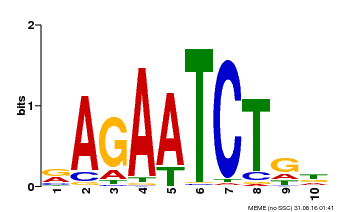 |
PlantRegMap/PlantTFDB v5.0
Plant Transcription
Factor Database
|
| Home TFext BLAST Prediction Download Help About Links PlantRegMap |
Transcription Factor Information
| Basic Information? help Back to Top | |||||||||
|---|---|---|---|---|---|---|---|---|---|
| TF ID | KFK40431.1 | ||||||||
| Organism | |||||||||
| Taxonomic ID | |||||||||
| Taxonomic Lineage |
cellular organisms; Eukaryota; Viridiplantae; Streptophyta; Streptophytina; Embryophyta; Tracheophyta; Euphyllophyta; Spermatophyta; Magnoliophyta; Mesangiospermae; eudicotyledons; Gunneridae; Pentapetalae; rosids; malvids; Brassicales; Brassicaceae; Arabideae; Arabis
|
||||||||
| Family | G2-like | ||||||||
| Protein Properties | Length: 423aa MW: 46750.3 Da PI: 6.4752 | ||||||||
| Description | G2-like family protein | ||||||||
| Gene Model |
|
||||||||
| Signature Domain? help Back to Top | |||||||
|---|---|---|---|---|---|---|---|
| No. | Domain | Score | E-value | Start | End | HMM Start | HMM End |
| 1 | G2-like | 90 | 2.2e-28 | 157 | 211 | 1 | 56 |
G2-like 1 kprlrWtpeLHerFveaveqLGGsekAtPktilelmkvkgLtlehvkSHLQkYRla 56
k +++WtpeLH+rFv+aveqL G +kA+P++ilelm+v++Lt+++v+SHLQkYR++
KFK40431.1 157 KVKVDWTPELHRRFVDAVEQL-GVDKAVPSRILELMGVHCLTRHNVASHLQKYRSH 211
5689*****************.********************************86 PP
| |||||||
| Protein Features ? help Back to Top | ||||||
|---|---|---|---|---|---|---|
| Database | Entry ID | E-value | Start | End | InterPro ID | Description |
| PROSITE profile | PS51294 | 18.375 | 154 | 213 | IPR017930 | Myb domain |
| Gene3D | G3DSA:1.10.10.60 | 1.6E-27 | 155 | 214 | IPR009057 | Homeodomain-like |
| SuperFamily | SSF46689 | 3.76E-18 | 156 | 214 | IPR009057 | Homeodomain-like |
| TIGRFAMs | TIGR01557 | 3.8E-26 | 157 | 211 | IPR006447 | Myb domain, plants |
| Pfam | PF00249 | 7.2E-8 | 160 | 209 | IPR001005 | SANT/Myb domain |
| Gene Ontology ? help Back to Top | ||||||
|---|---|---|---|---|---|---|
| GO Term | GO Category | GO Description | ||||
| GO:0007165 | Biological Process | signal transduction | ||||
| GO:0009658 | Biological Process | chloroplast organization | ||||
| GO:0009910 | Biological Process | negative regulation of flower development | ||||
| GO:0010380 | Biological Process | regulation of chlorophyll biosynthetic process | ||||
| GO:0010638 | Biological Process | positive regulation of organelle organization | ||||
| GO:0045893 | Biological Process | positive regulation of transcription, DNA-templated | ||||
| GO:1900056 | Biological Process | negative regulation of leaf senescence | ||||
| GO:0005634 | Cellular Component | nucleus | ||||
| GO:0003700 | Molecular Function | transcription factor activity, sequence-specific DNA binding | ||||
| GO:0044212 | Molecular Function | transcription regulatory region DNA binding | ||||
| Sequence ? help Back to Top |
|---|
| Protein Sequence Length: 423 aa Download sequence Send to blast |
MLALSPARNT TRDEDSEFFD TSCGFTIDPE EDFPEFGDHG DLLDIIDFDD LFGVAGDVLP 60 DLEIDPEILT GDFSDHMNAS STITTSSSEK ADSQGETYDN NKGISGKSEE VVSKRDDVEA 120 PVAETVNYDG DNDRKRKYPS SNSSKNNRIS NNEGKRKVKV DWTPELHRRF VDAVEQLGVD 180 KAVPSRILEL MGVHCLTRHN VASHLQKYRS HRKHLLAREA EAANWTRKRH IYGLDNVSNT 240 NGRNKNGWLA PAPTIGFPPP PPVAVAPAPP VHHHFRPLHV WGHPTVDQSV MPHVWPKHLP 300 PPSTPMATPP FWVSDSPYWH RIHNGTNPYL PTVTRYRAPP VAGIPQAMPP HHTVYKSAHG 360 FGGAHPPVDL HPSKETIDAA IGDVLTRPWL PLPLGLKPPA VDGVMTELHR HGVSEVPPTA 420 SCA |
| 3D Structure ? help Back to Top | ||||||
|---|---|---|---|---|---|---|
| PDB ID | Evalue | Query Start | Query End | Hit Start | Hit End | Description |
| 5lxu_A | 1e-15 | 162 | 213 | 6 | 57 | Transcription factor LUX |
| Search in ModeBase | ||||||
| Functional Description ? help Back to Top | ||||||
|---|---|---|---|---|---|---|
| Source | Description | |||||
| UniProt | Transcriptional activator that functions with GLK2 to promote chloroplast development. Acts as an activator of nuclear photosynthetic genes involved in chlorophyll biosynthesis, light harvesting, and electron transport. Acts in a cell-autonomous manner to coordinate and maintain the photosynthetic apparatus within individual cells. May function in photosynthetic capacity optimization by integrating responses to variable environmental and endogenous cues (PubMed:11828027, PubMed:12220263, PubMed:17533111, PubMed:18643989, PubMed:19376934, PubMed:19383092, PubMed:19726569). Prevents premature senescence (PubMed:23459204). {ECO:0000269|PubMed:11828027, ECO:0000269|PubMed:12220263, ECO:0000269|PubMed:17533111, ECO:0000269|PubMed:18643989, ECO:0000269|PubMed:19376934, ECO:0000269|PubMed:19383092, ECO:0000269|PubMed:19726569, ECO:0000269|PubMed:23459204}. | |||||
| Binding Motif ? help Back to Top | |||
|---|---|---|---|
| Motif ID | Method | Source | Motif file |
| MP00022 | PBM | Transfer from AT2G20570 | Download |

| |||
| Cis-element ? help Back to Top | |
|---|---|
| Source | Link |
| PlantRegMap | KFK40431.1 |
| Regulation -- Description ? help Back to Top | ||||||
|---|---|---|---|---|---|---|
| Source | Description | |||||
| UniProt | INDUCTION: By light. Repressed by BZR2. {ECO:0000269|PubMed:12220263, ECO:0000269|PubMed:21214652}. | |||||
| Regulation -- PlantRegMap ? help Back to Top | ||||||
|---|---|---|---|---|---|---|
| Source | Upstream Regulator | Target Gene | ||||
| PlantRegMap | Retrieve | Retrieve | ||||
| Annotation -- Protein ? help Back to Top | |||||||
|---|---|---|---|---|---|---|---|
| Source | Hit ID | E-value | Description | ||||
| Refseq | XP_020888082.1 | 0.0 | transcription activator GLK1 isoform X1 | ||||
| Swissprot | Q9SIV3 | 0.0 | GLK1_ARATH; Transcription activator GLK1 | ||||
| TrEMBL | A0A087HE79 | 0.0 | A0A087HE79_ARAAL; Uncharacterized protein | ||||
| STRING | A0A087HE79 | 0.0 | (Arabis alpina) | ||||
| Orthologous Group ? help Back to Top | |||
|---|---|---|---|
| Lineage | Orthologous Group ID | Taxa Number | Gene Number |
| Malvids | OGEM2209 | 27 | 73 |
| Best hit in Arabidopsis thaliana ? help Back to Top | ||||||
|---|---|---|---|---|---|---|
| Hit ID | E-value | Description | ||||
| AT2G20570.1 | 0.0 | GBF's pro-rich region-interacting factor 1 | ||||



